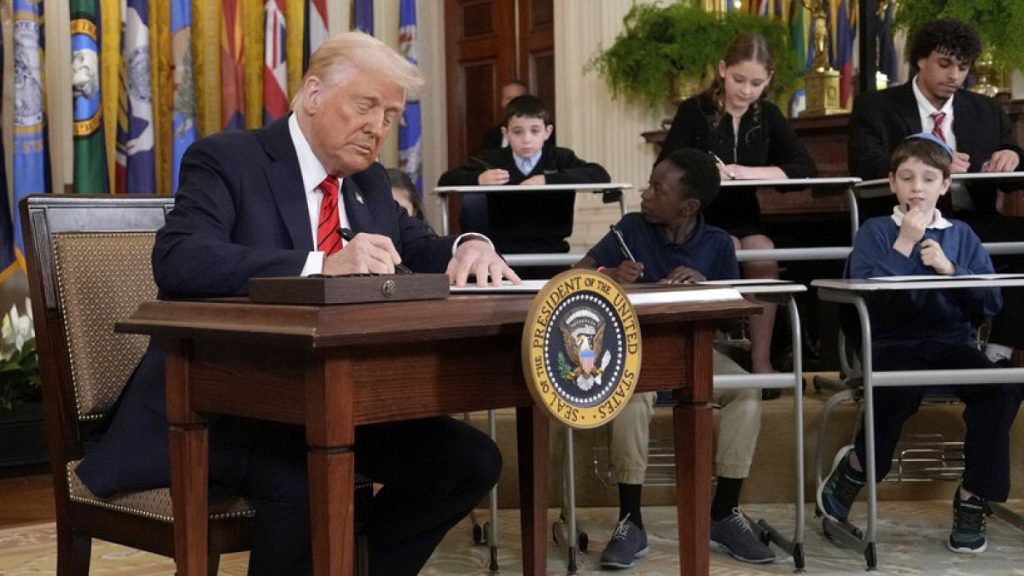In a bold move fulfilling a campaign promise, President Donald Trump signed an executive order on Thursday aimed at dismantling the U.S. Department of Education. Citing the agency’s inefficiency and perceived liberal bias, Trump stressed the need to transfer educational authority back to states and local communities. This announcement has elicited mixed reactions, with some advocacy groups celebrating the decision while others, including educational advocates, express concerns about the implications for students across the nation.
| Article Subheadings |
|---|
| 1) Overview of Executive Order to Dismantle Education Department |
| 2) Goals Behind the Decision |
| 3) Reactions from Key Stakeholders |
| 4) Legal and Legislative Challenges Ahead |
| 5) The Impact on American Education |
Overview of Executive Order to Dismantle Education Department
On Thursday, President Trump signed a significant executive order aimed at dismantling the U.S. Department of Education, claiming that the agency falls prey to wasteful practices and liberal ideologies. The order mandates that Education Secretary Linda McMahon take steps to close the department while retaining its basic functions, such as Title I funding, Pell Grants, and support for students with disabilities. This pivotal move is seen as a direct fulfillment of Trump’s 2024 campaign promise, where he pledged to eliminate what he regards as an ineffective government body responsible for overseeing education in the United States.
Goals Behind the Decision
The executive order is positioned as a response to what Trump describes as America’s lagging performance in academia. In his view, empowering states to take charge of their educational frameworks will yield better outcomes for students. Trump stated, “It’s doing us no good,” emphasizing that localized governance would facilitate a more effective educational system. This decision appears to resonate with a segment of the population that views federal oversight as overreaching and unnecessary, arguing instead for localized control as a means to enhance the quality of education.
Reactions from Key Stakeholders
The announcement has drawn polarized reactions from various stakeholders. Supporters of the decision, particularly those who have long advocated for the dissolution of the Department of Education, hailed it as a much-needed reform. Conversely, educational advocates and critics argue that dismantling the agency threatens equitable education for millions of American children. Derrick Johnson, President of the NAACP, described the move as “a dark day for the millions of American children who depend on federal funding for a quality education.” Concerns center around the impact on low-income, rural, and underfunded schools that rely heavily on federal assistance.
Legal and Legislative Challenges Ahead
Despite Trump’s executive directive, the actual dismantling of the U.S. Department of Education is likely to face substantial legal and legislative hurdles. Established by Congress in 1979, the dissolution of the department would require legislative action, a process that faces opposition from a Democrat-controlled Congress. Senate Minority Leader Chuck Schumer labeled the order “a tyrannical power grab” and criticized it as “one of the most destructive and devastating steps Donald Trump has ever taken.” His remarks reflect the broader political dynamics that will likely influence the feasibility of Trump’s initiative.
The Impact on American Education
If implemented, the dismantling of the Department of Education could result in drastic changes to the landscape of American education. While the Trump administration argues that states would be better suited to manage educational systems, critics worry that this decentralization could exacerbate existing inequities in educational access and quality. With potential reductions in federal oversight and funding, students in underprivileged areas may face significant challenges, lacking the resources necessary for a well-rounded education. Furthermore, the transition of responsibilities raises questions about the continuity of critical programs aimed at helping students succeed.
| No. | Key Points |
|---|---|
| 1 | President Trump signed an executive order to dismantle the U.S. Department of Education. |
| 2 | The order emphasizes transferring educational authority back to states and local communities. |
| 3 | Supporters see it as a step towards effective education, while critics warn of potential negative impact on federal funding for schools. |
| 4 | The move faces significant legislative hurdles, as dismantling the department would require Congressional action. |
| 5 | Experts express concern about increased educational inequalities if federal oversight is reduced. |
Summary
The executive order signed by President Trump targeting the dismantlement of the U.S. Department of Education marks a pivotal moment in American education policy. While the intent behind the decree aims to transfer power to states for more tailored educational governance, the implications for students, particularly in marginalized communities, could be severe without federal support. As the political landscape evolves, the success of Trump’s initiatives hinges on legislative cooperation and ongoing public dialogue regarding the fundamental goals of American education.
Frequently Asked Questions
Question: What does the executive order entail?
The executive order signed by President Trump calls for the dismantling of the U.S. Department of Education and aims to return educational authority to states and localities.
Question: Who is responsible for implementing this order?
Education Secretary Linda McMahon has been assigned the task of facilitating the closure of the Department of Education while preserving critical functions.
Question: What challenges might the order face?
The dismantling of the department likely requires legislative action due to its establishment by Congress in 1979, and faces opposition from Democrats.


